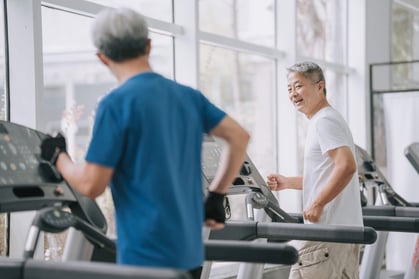 Congratulations! You’ve decided to get started with your fitness journey! Now what?
Congratulations! You’ve decided to get started with your fitness journey! Now what?
Deciding that you want to begin a regular exercise routine can be a big step, but once you make that decision, getting started can be intimidating. Here are some simple steps to take to get you on the right track. It’s important to note that you should receive clearance from your doctor before beginning a new exercise program.
- Figure out what type of exercise you enjoy. If you have exercised in the past, what did you enjoy doing then? What type of exercise sounds enjoyable to you? Do you enjoy group classes, exercising with a friend, or by yourself? Do you enjoy being outside or prefer indoors? Ask yourself these types of questions. It’s important that you find some enjoyment in the exercise that you are doing, otherwise you are less likely to stick with it. If you aren’t sure what you enjoy, try a few different classes, try going for a few walks, try out the exercise equipment in the fitness center, or schedule a fitness evaluation with the fitness staff so they can give you guidance.
- Make a schedule. Another great way to make sure you stick with your exercise routine is to make a schedule. Figure out how many days per week you are going to exercise, what time of day, and how many minutes. It will vary depending on everyone. In general, I recommend starting with 2-3 days per week for 20-30 minutes. The time of day will depend on if you are a morning person or evening person. Whenever you feel you have the most energy or have room in your schedule is when you should schedule your exercise.
- Find your “Why”. Why did you decide to start your fitness journey? Your first thought might be something straightforward, such as to improve your balance, to move better, to get stronger, etc. Try taking it a step farther. Why do you want to move better? The answer to that could be anything, but an example may be something like “So that I can do more activities with my grandkids.” It’s important to have a strong enough reason why you are starting or continuing your exercise program, so that on days you don’t feel like doing it, you can come back to that reason and remind yourself why you are doing it.
- Give yourself grace. I think another part of getting started with an exercise routine that can be intimidating is thinking that it must be all or nothing. As a fitness professional, I am all about helping people find ways to make exercise a part of your daily life, but that doesn’t mean your whole routine and progress is thrown off if you miss a day or even a week. Sometimes things happen, you get sick, or your spouse has medical issues, or a family member needs help, or anything unplanned happens to throw off your schedule. That’s OK! We can’t prepare for these things, so it’s important to not be too hard on yourself if your exercise routine gets pushed aside while you’re dealing with whatever is going on. All you can do is start back up once things have calmed down.

 We all know that exercise is great for your health, but too often we think of improving our health as being able to move better, losing weight, having more energy, decreasing stress, or even improving our heart health, which are all great benefits don’t get me wrong! However, did you know that exercise can improve our memory and cognitive function as well? If not, you aren’t alone. The benefits that exercise can give our brain often tend to be overlooked.
We all know that exercise is great for your health, but too often we think of improving our health as being able to move better, losing weight, having more energy, decreasing stress, or even improving our heart health, which are all great benefits don’t get me wrong! However, did you know that exercise can improve our memory and cognitive function as well? If not, you aren’t alone. The benefits that exercise can give our brain often tend to be overlooked.